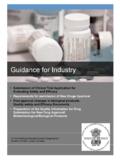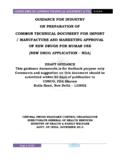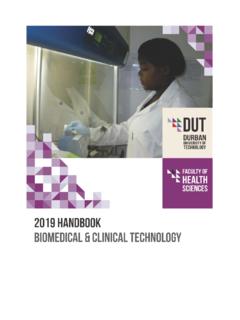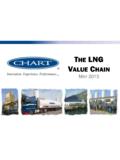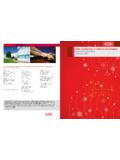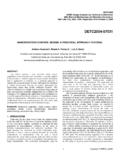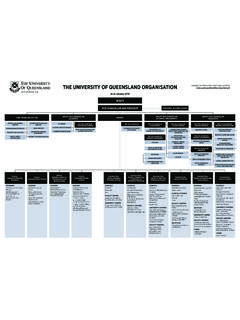Transcription of National guidelines for waste management in the …
1 National guidelinesfor waste managementin the health industryEndorsed March 1999 NHMRCN ational Health and Medical Research Councilii Commonwealth of Australia 1999 ISBN 1864960256 This work is copyright. Apart from any use as permitted under the Copyright Act 1968, no partmay be reproduced by any process without permission from AusInfo. Requests and enquiriesconcerning reproduction and rights should be addressed to the Manager, Legislative Services,AusInfo, GPO Box 1920, Canberra ACT strategic intent of the National Health and Medical Research Council (NHMRC) is to work withothers for the health of all Australians, by promoting informed debate on ethics and policy, providingknowledge-based advice, fostering a high quality and internationally recognised research base, andapplying research rigour to health documents are prepared by panels of experts drawn from appropriate Australian academic,professional, community and government organisations.
2 NHMRC is grateful to these people for theexcellent work they do on its behalf. This work is usually performed on an honorary basis and inaddition to their usual work document is sold through AusInfo Government Info Bookshops at a price which covers theprice which covers the cost of printing and distribution only. For publication purchases pleasecontact AusInfo on their toll-free number 132 447, or through their internet address: 1 INTRODUCTION1 Chapter Organisational Containers, storage and Treatment and disposal Clinical waste disposal in the home7 Chapter 3 CATEGORISATION OF Clinical Laboratory and associated waste directlyinvolved in specimen Human Animal tissue or Other waste designated as Related Cytotoxic Pharmaceutical Chemical Radioactive General Disposable Plastics18viivCONTENTSC hapter 4 ORGANISATIONAL waste management waste management waste waste Product Product Procedural Reusable Extended producer waste Recycling and Paper and waste tracking28 Chapter 5 waste CONTAINERS.
3 STORAGE AND TRANSPORT Sharps Plastic Rigid-walled On-site Off-site Spill management33vCONTENTSC hapter 6 TREATMENT AND DISPOSAL Chemical Other treatment options40 Chapter 7 OCCUPATIONAL HEALTH AND Education and Occupational health and safety Standard operating Monitoring performance43 Chapter 8 CLINICAL waste DISPOSAL IN THE HOME44 Glossary45 Appendix AProcess report: Members of the working panel49 Appendix BList of public submissions received51 Bibliography53 Address for correspondence59 PREFACEThis is the first revision of the National guidelines for the management of Clinicaland Related Wastes, which was published by the National Health and MedicalResearch Council (NHMRC) in 1988.
4 In this revision the National guidelines havebeen expanded by the addition of details of waste management such as audit,segregation and minimisation, and recommendations for the disposal of wider scope of the 1999 guidelines is reflected in the title, NationalGuidelines for waste management in the Health aspects of the recommended National strategy for clinical and related wastesrequire special emphasis: the need for a consistent National approach, and theneed for a realistic, scientific appraisal of the actual risks associated with healthindustry States and Territories should negotiate detailed and consistent definitions ofthe terms used in the documentation of their waste management requirementsthrough regular consultation.
5 This document leads the way in facilitating aconsistent National approach to the management of clinical and related some categories of waste (such as cytotoxic and radioactive waste ) canundoubtedly be hazardous in certain circumstances, the risk associated withclinical waste has often been exaggerated and has caused emotive epidemiological studies throughout the world have failed to establish arisk attributable to hospital waste to health-care workers, waste transport staff orthe public, apart from the danger of needle-stick injuries causing , this should not promote a false sense of security in the managementof hospital the costs involved with waste disposal are rising, greater emphasis is nowplaced on financial considerations in waste management .
6 The introduction of thepractices described in these National guidelines , such as appropriate segregationand minimisation of waste , can significantly reduce the costs of waste and environmental considerations should be balanced with the need tosafely manage materials which may present public and workplace risk, potentialrisk or public is expressed to officers of Queensland Health, who wrote thesection on radioactive assistance provided by Dr Robert Baker of Chem Affairs, Sydney, andProfessor David Moy of techSearch, Salisbury, Queensland, in finalising thisrevision, is acknowledged with National guidelines for health industry waste management aim to enhanceand protect public health and safety; to provide a safer working environment; tominimise waste generation and the environmental impact of waste treatment anddisposal and to facilitate compliance with regulatory guidelines outline procedures for the classification, segregation, safe packaging(containment), labelling, storage, transport and disposal of clinical and relatedwastes.
7 They are intended to assist authorities and practitioners, as well as otherpeople involved (whether directly or indirectly), in determining an appropriate wastemanagement strategy. The unique and specific factors applicable to each situation the local conditions, requirements and regulations, and the type and volume ofwaste generated should all be taken into account when formulating has been universal difficulty within the numerous groups that work inhealth care establishments in reaching a satisfactory definition of clinical andrelated wastes. The terms hospital waste , clinical waste , infectious waste , medicalwaste, biomedical waste and biohazardous waste are often used synonymously,but inappropriately.
8 The definitions of waste capable of producing human harmmust be precise, but not this document, health industry wastes are defined as all types of wastes(clinical, related and general) arising from medical, nursing, dental, veterinary,pharmaceutical, or similar practices, and wastes generated in hospitals or otherfacilities during the investigation or treatment of patients or in research waste includes the following categories: discarded sharps; laboratory and associated waste directly involved in specimen processing; human tissues, including materials or solutions containing free-flowing blood;and animal tissue or carcasses used in 1 Introduction2 National guidelines for waste management in the health industryRelated waste includes: cytotoxic waste ; pharmaceutical waste ; chemical waste ; and radioactive document will consider the management of wastes that do not fall into theabove categories under the heading of general waste .
9 General waste is includedin the guidelines to assist waste generators to develop a comprehensive wastemanagement assessmentGeneral waste constitutes the bulk of waste generated by health care institutions,and is no more of a public health risk or concern than domestic or householdwaste. Likewise, if properly managed, the components of the clinical and therelated waste streams present no actual risks to workers, whether clinicians orwaste perceptions that any hospital waste is somehow dangerous indicate a need for wider dissemination of the results of epidemiological healthindustry waste studies to date, and further study/analysis of waste streamcomponents in the Australian setting.
10 *Clinical and related wastes can present handling, storage, transport and/ordisposal problems for the following reasons: the potential risk to personnel involved in the disposal of some of thesewastes, and to the public, if it is not managed correctly; and the potential for pollution of the environment or visual offence if wastes arenot disposed of properly.* Key overseas references to date include: The Public Health Implications of Medical waste : A Report to Congress (1990), Agency for ToxicSubstances and Disease Registry, Washington, Department of Health and Human Services; Shaping State and Local Regulation of Medical waste and Hazardous Materials, (1990),Report of theAd Hoc Committee on Medical waste and Hazardous Materials, Chicago, American HospitalsAssociation; Society for Hospital Epidemiology of America, Position Paper: Medical waste , (1992), Rutala, WA andMayhall, CG, Infection Control and Hospital Epidemiology, Volume 13, pp 38 48.
